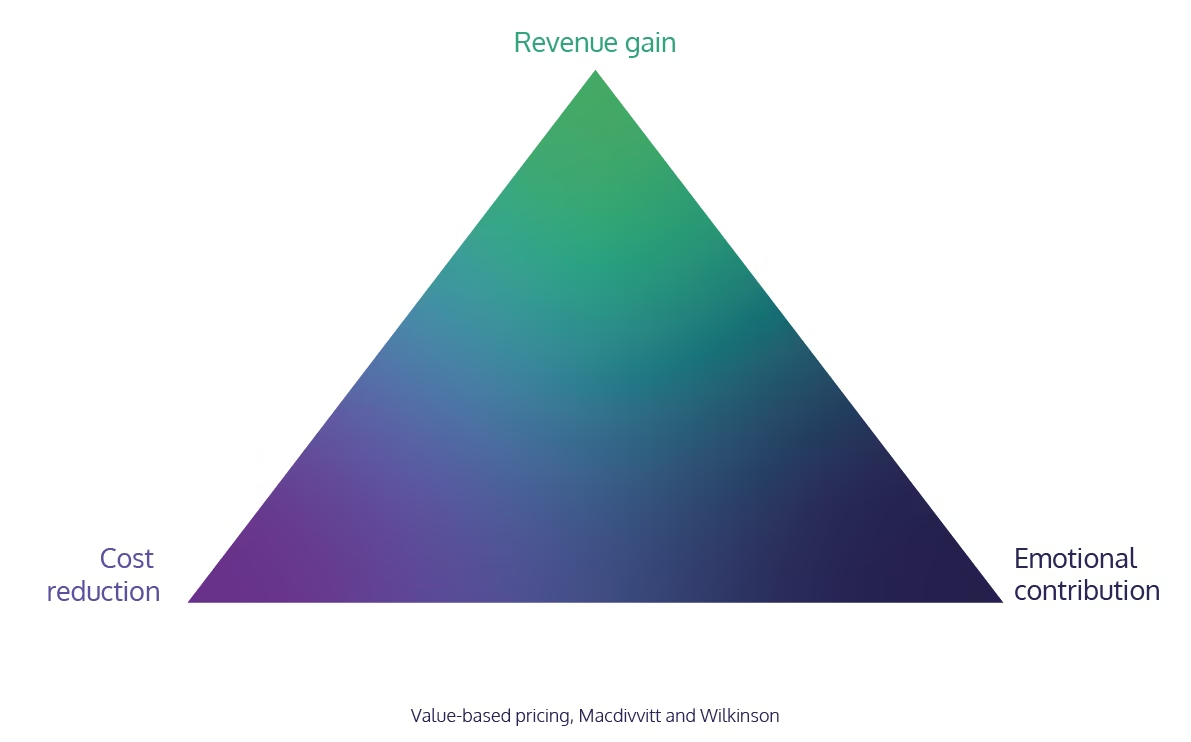In the first part of our Pricing Guide for Freelancers, we talked about the importance of understanding the absolute minimum price you should charge to keep the lights on.
Then, in parts 2, 3, and 4, we talked about the pros and cons of various pricing models: charging an hourly rate, charging a fixed rate, and using a ‘package deals’ model.
But for each of these models our biggest consideration was the costs to you, the freelancer. The cost of your time. All the overheads. The admin.
Your customers, however, think about the price differently. For them, it’s all about value.
Value comes from three places:
- Your ability to increase revenue
- Your ability to cut costs
- Your emotional contribution
You can think of this as a triangle.
The value triangle
How you should think about value from your clients’ perspectives

If you take your minimum cost as a starting point, you can use these three factors to charge over and above that number, to gain some of the actual value you create for your clients - rather than just charge a figure that helps to meet your own costs.
All three of these things contribute to value. You don’t necessarily have to have all three as part of what you offer to clients, but you should be sure to position your offer in terms of at least one of these.
If you want to focus narrowly on one, you’ll need to do a really good job of it, as you’ll be vulnerable to other freelancers who can achieve two or three. Conversely, if you choose to do two or three, you’ll need to be careful not to spread yourself too thin.
The key is to be really honest with yourself about which of these areas you are strongest in - and then structure your services around them.
Let’s go over them in more detail.
Revenue gain and cost reduction
These two are fairly self-explanatory. The more you can contribute to your client increasing revenue, and the more you can help to reduce a client’s costs, the more value you are adding. If you can figure this out, or even just estimate it, you can then try to set your price based on the numbers you come up with.
By thinking this way, you can better justify a price you come up with, and move the discussion away from your costs (like your hourly rate) and towards the value you’re actually creating for your client. After all, that’s what they’re buying at the end of the day.
Emotional contribution
This one is harder to quantify, if it’s possible at all - but it’s also arguably the most important of the three pieces of the triangle. It’s the feeling your client gets from hiring you. This could be peace of mind, it could be less hassle, it could be the ability to advance their own career.
These things come less from your work itself, and more in how you conduct yourself. Things like:
- Ability to deliver on time
- How easy you are to work with. Do you respond to emails? Do you huff and puff when briefs change?
- Do you have a good reputation?
The reality is, things like this are going to contribute a lot of value compared to the “bottom line” benefits we talked about before. This makes a lot of sense when you scratch the surface of it. A mid-level person in a corporation or other large organisation is going to be embarrassed if they hire a freelancer who doesn’t deliver on time. That project is their responsibility, and it’s going to be their reputation that suffers.
If one freelancer consistently delivers on time, while another freelancer delivers at random times, but increases revenue a bit more or cuts costs a bit more, the mid-level person is still probably going to go with the freelancer who delivers on time.
So think about your client base, and the emotional contribution you offer them. Consider calling these things out in your pricing - after all, that’s what your clients are paying for.
Justifying your price
Once you have identified how much you will focus on each of these three things, you can use them to justify your price. Rather than just give a price, give a price with an explanation. Explain how your solution is going to do each of these three things, and the value of them.
This approach lets you move away from pricing based on costs (which is limited to your costs) and towards pricing based on value, which is only limited by the amount of value you create for your clients.
